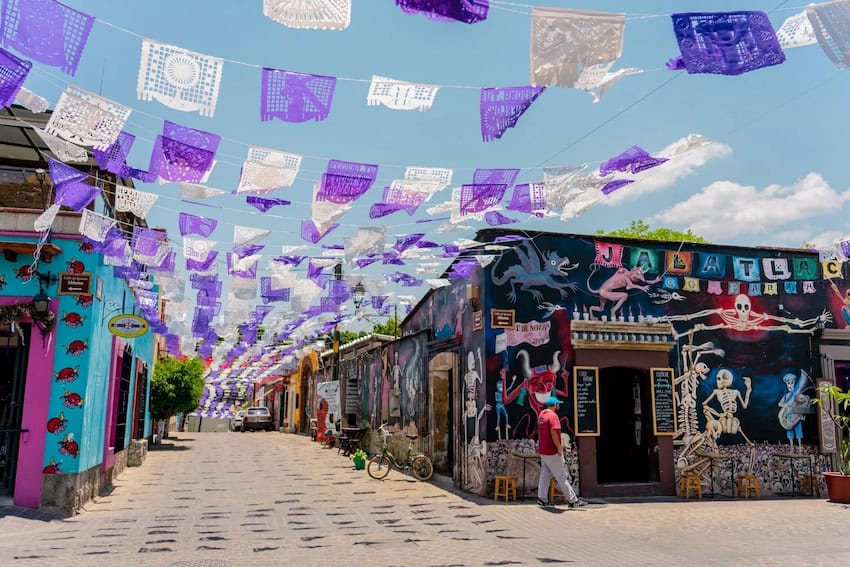I’ve just gotten back from my third trip to Oaxaca city. They say the third time’s the charm, and now I know what they mean. Until now, I just didn’t understand the hype. I liked Oaxaca, sure, but it seemed like everyone I knew absolutely loved it.
Oaxaca is pretty. It’s clean. It’s charming. It just never swept me off my feet.
This time was different. Had I known before that all I needed to do was wander beyond the Historic Center, I would have meandered into Xochimilco and Jalatlaco so I could discover the magic that everyone else saw right away. It was in these two neighborhoods, on the outskirts of the lively downtown, that I fell in love with Oaxaca. Was it their colorful murals? The unexpected juice bars? Or was it the common thread I later uncovered that tied the two zones together? After all, Xochimilco and Jalatlaco are the two oldest neighborhoods in Oaxaca City, each with their own personality, history and appeal.
Xochimilco: Quiet streets meet Zapotec heritage

I stumbled upon Xochimilco in an innocent, yet desperate, attempt to find a salad. Oaxaca is widely recognized for its culinary prowess, but after a few days of mole and mezcal, the body starts craving vitamins.
Nearing my destination, I noticed the roads getting windier, the facades quirkier and the views more dramatic. Murals of hummingbirds and historical figures sprouted from cobblestone streets while bright bougainvillea cascaded down from the rooftops. What I noticed above all, however, was how incredibly quiet it was: just me, the birds and an occasional lonesome tourist.
Xochimilco is recognized as one of Oaxaca city’s oldest neighborhoods, or barrios, as they’re called herein Oaxaca. Like Jalatlaco, it was a Zapotec settlement prior to Spanish colonization. Unlike other neighborhoods that were swallowed by colonial customs, Xochimilco has maintained its distinct Indigenous cultural and religious traditions to this day. Which raises the question: why does this neighborhood, separated from the nation’s capital by 300 miles and several mountain chains, have the same name as Xochimilco in Mexico City? That’s because the Mexica (Aztecs) invaded modern-day Oaxaca in 1486 and brought with them Xochimilcan soldiers who, naturally, named the settlement after their own hometown.
As part of Oaxaca city’s Historic Center, Xochimilco is protected under federal law as a historic monument zone. Most of these monuments were built by the Spanish, including the striking 18th-century San Felipe Aqueduct and the 16th-century Parroquia de Santo Tomás. There is also the bustling Mercado Sánchez Pascuas, where vendors sell traditional Oaxacan foods, and Calle Rufino Tamayo, known for its bold and colorful street art. Plazuela de la Cruz de Piedra is the barrio’s public square, and there is no shortage of cafes, restaurants, galleries and artisan workshops that offer visitors a peek into the daily life of a Xochimilco resident.
Where to eat in Xochimilco: Ancestral Cocina Tradicional, celebrated for elevated Oaxacan cuisine with a twist in a lush garden setting and El Empedrado, for a cozy, casual environment that includes rooftop seating and live music.
Jalatlaco: Colonial history meets contemporary art

I discovered Jalatlaco more intentionally. Feeling like I had exhausted what there was to see in the Historic Center, I asked Google to recommend some hidden gems. Jalatalco topped the list, and popping over I could feel the difference immediately. Named Oaxaca city’s first Barrio Mágico in 2023, the neighborhood, livelier than Xochimilco but more chill than the area around the Zócalo, felt truly local. I passed an artist painting a giant mural of corn, each kernel a different shade of gold and purple. I walked behind an older gentleman in a cowboy hat on his way to lunch. I even passed by NN Gallery, a contemporary art space showcasing regional talent.
Above me were rooftop restaurants, with groups of Oaxacan 20-somethings laughing over pizza. There was artwork at every corner, and when I returned later that night for dinner, the streets were lined with string lights.
Like Xochimilco, Jalatalco was historically inhabited by indigenous Zapotec communities and was occupied by Mexica soldiers in 1486. During colonization, the Spanish under Francisco de Orozco converted the old village into a Spanish enclave. That’s why the most recognized historical attraction is colonial: the Temple of San Matías Jalatlaco, which has origins tracing back to the early 17th century, can be easily distinguished by its green-hued stone facade.
In the late 19th and early 20th centuries, the leather tanning industry flourished in Jalatlaco due to its proximity to the Jalatlaco River. With the rise of synthetic materials and the extinction of the river, the craft disappeared here but still remains a key part of the barrio’s history. The Jalatlaco Entrance Arch is a fun photo-op and guides you directly to Calle Aldama, a picturesque street that embodies the artistic essence of the neighborhood.
Where to eat in Jalatlaco: Asador Bacanora Oaxaca, a trendy outdoor dining experience with a Michelin-recommended menu creatively highlighting both Oaxacan and Mexican dishes and Santa Hierba Jalatlaco for a tropical brunch vibe with rooftop seating, featuring a menu that caters to a variety of dietary preferences.
Bethany Platanella is a travel planner and lifestyle writer based in Mexico City. She lives for the dopamine hit that comes directly after booking a plane ticket, exploring local markets, practicing yoga and munching on fresh tortillas. Sign up to receive her Sunday Love Letters to your inbox, peruse her blog or follow her on Instagram.
